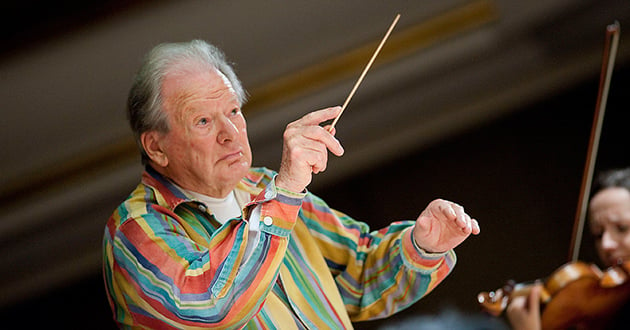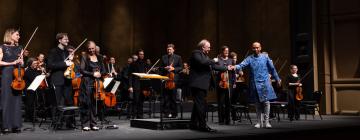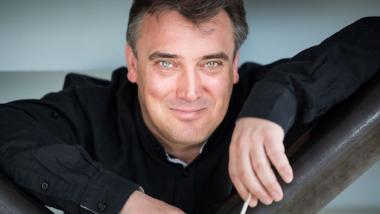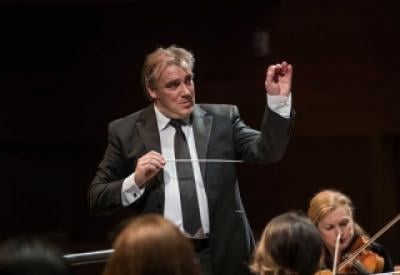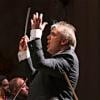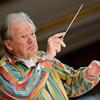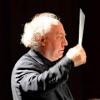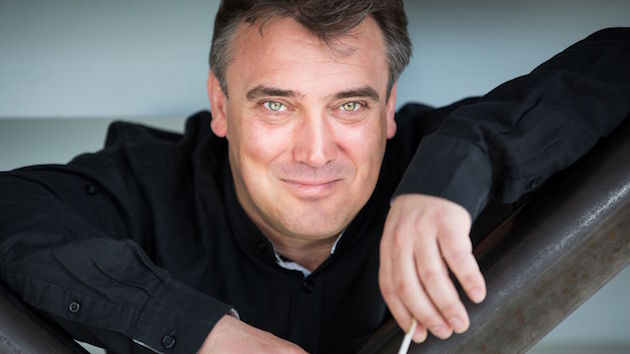
How does one make the transition from being a world-class solo flutist to taking the podium and conducting the top-tier orchestras of today? For Jaime Martín, who is about to begin his tenure as the sixth music director of the Los Angeles Chamber Orchestra when he leads the ensemble in concerts on Sept. 28 and 29, his musical path has proven, in a way, pre-ordained, as well as deeply rewarding.
Growing up in Santander, a small town in the north of Spain situated between Bilbao and Gijón, Martín was taken to a concert where he heard the music of Tchaikovsky and Mussorgsky. He was 9 years old at the time, and from that day forward, Martín, who then began studying the flute, was forever hooked on music. Becoming a member of the National Youth Orchestra of Spain at age 13, the teen went on to become principal flute with, among others, the Academy of St. Martin in the Fields, the Royal Philharmonic Orchestra, and the London Philharmonic Orchestra.
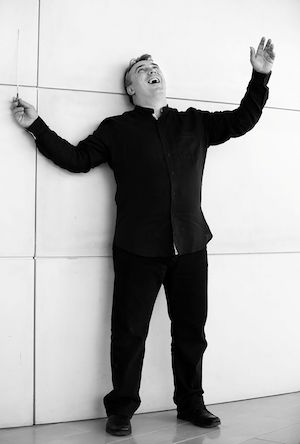
He also worked regularly as a member of the Chamber Orchestra of Europe, and in 1991, Martín, now 54, made his debut as a soloist at Carnegie Hall. The musician has also recorded chamber music with the Brindisi String Quartet, Pinchas Zukerman, and others, as well as making a recording of Mozart flute concertos with Sir Neville Marriner. In addition, Martín is a founding member of the Cadaqués Orchestra and a Fellow of the Royal College of Music in London, where he was a flute professor.
Turning to conducting full-time in 2013, the musician has worked with a who’s who of orchestras, with The Telegraph’s John Allison writing that, “Martín’s detailed performance [of Mendelssohn’s ‘Scottish’ Symphony] took on heady swagger and his infectious enjoyment of the music communicated to the orchestra and audience alike.” Indeed, in 2013, the maestro became artistic director and principal conductor of Gävle Symphony Orchestra, and this year he was appointed principal conductor of the RTE National Symphony Orchestra.
Highlights of Martín’s recent seasons include debuts with the Bilbao Symphony and Essen Philharmonic, as well as bringing the Cadaqués Orchestra to Salzburg in a three-concert residency at the Grosses Festspielhaus. And coming full circle, the musician, who makes his home in London, has for the last six years been helming the 68-year old, month-long Santander Festival — where he heard his first orchestral concert as a wide-eyed boy. I caught up with the Spaniard by phone from the small coastal town where the musical goings-on were in full swing.
Santander holds a special place in your heart. What are your memories of that first concert you attended, as I understand there wasn’t music in your family?
Not my parents or my brothers played music, but my father really loved to listen to music. He was the ideal music consumer and when I was nine he took me to a concert. The first piece was Tchaikovsky’s Fifth and then Mussorgsky’s Pictures at an Exhibition. That was a disaster for me — a disaster in a good way — because I loved it so much, because this is what I do now. From the first chord, with the clarinets, the strings, I had tears in my eyes, I remember that.
When I think back about that time, it’s not because I understood the music or the message of Tchaikovsky, but the sheer impression of having an orchestra in front of me. It was a life event. There’s something about an orchestra on the stage — the sound of an orchestra — it’s completely irresistible. I can’t imagine anybody to be in front of an orchestra and be indifferent to these sounds. It is magic, and the next day I said to my parents that I wanted to play an instrument.
It’s not every flutist who becomes a conductor. How did you make that career shift?
I think I knew I wanted to be a conductor since I was a student. When I was in the Hague studying flute, I enrolled in the conducting class and conducted a few concerts with the chamber orchestra. Already this was something that fascinated me, but very soon, during the time of studying, I became a member of the European Youth Orchestra conducted by Claudio Abbado. The first project with him was [Schoenberg’s] Gurrelieder. Suddenly you have this amazing orchestra and I remember thinking, “If I become a conductor at this stage, I will never have the ability to experience things like this. I wouldn’t have the chance to work with Claudio.” It was too sad to leave that.
So you stuck with the flute, performing under such luminaries as Georg Solti, Lorin Maazel, Zubin Mehta, and Nikolaus Harnoncourt.
Yes. For somebody that wanted to know about conducting, I was in the best conducting class I could think of — sitting in the orchestra with these musicians. I was happy playing the flute and at some point, somebody asked me to conduct and I did. This led to another invitation and Marriner said to me, ‘In five years’ time you will not play flute anymore.’ And that’s what happened.
Since its founding in 1968, LACO has had five music directors, including Jeffrey Kahane — whom you’re succeeding — as well as Iona Brown, and Neville Marriner, who was an important influence in your life. What does this appointment mean to you?
I have heard about the orchestra through Marriner’s stories. I was very close to Neville when I was a player in his [Academy of St Martin in the Fields] orchestra. I heard so many things about LACO from him — when he was there and met Jascha Heifetz in L.A. and he used to play string quartets. Iona Brown I knew very well and she was also directing St Martin’s.
My first rehearsal with LACO was the Brahms Serenade No. 1, and I felt so free. Being a conductor, everywhere you conduct different orchestras and my job is to try and encourage the musicians to come close to my ideas. Sometimes it’s difficult, sometimes easy. You don’t have much time to establish a connection, but with LACO, I felt like after five minutes it was so nice. It feels like a glove that’s the right one for your hands. It was a wonderful experience.
I thought the [Oct. 2017] concerts went well and that was it. Then I got a phone call and they wanted to do a concert with me again soon, before the season finished. I came back a few months later to do a private concert [that] happened in January, and I was offered the job in February. It all happened very quickly and it’s difficult to explain, but it’s a wonderful feeling of trust. I trust the orchestra and I feel the orchestra trusts me. I think trust in any relationship is the most important part of it — in music or in life. I think we are starting on the right foot, so I am excited about working with the orchestra.
Let’s talk about LACO’s season. You’ll be conducting seven programs, including three world premieres, a U.S. premiere/co-commission, and a West-Coast premiere. The first concert is with Anne Sofie von Otter, with music by Berlioz, Beethoven, and Andrew Norman.
I thought a lot about what I want to do with LACO in my first year. Since I haven’t done very much conducting in the States, and people don’t know who I am, I wanted to organize a season to bring a few of the soloists that I really admire — that have been important in my life. I wanted to show them who my friends are, and if you like my friends, you’ll like me.
That’s why I wanted to do something with Anne Sofie. This was my starting point. With her, my first experience was Così fan tutte with Solti. We recorded it for Decca and being in the orchestra listening to Anne Sofie, this was incredible. Over the years I worked with her many times as a flutist and conductor, and when I realized she has never been to LACO I thought I have to bring her to the first concert. This is how I felt about others — Christian Tetzlaff — I have played chamber music with him for many years, and he will play Beethoven [in February].
With Andrew, I knew he’d been composer-in-residence at LACO and I had a long conversation with him and said, ‘I want you to write a piece for the opening concert — a concerto for chamber orchestra that reflects the talents of LACO. You know the players and what they like. I want it to reflect their personalities. He was excited about that but due to his commitments he said he didn’t know if he will have time.
So this piece is in three movements — a movement a year. It’s kind of like a Netflix series — to be continued. I wanted to create excitement. The reason I am explaining this to you is that always behind an idea is a very long process. All these ideas start like a dream and slowly it starts taking form. Suddenly it’s on a piece of paper and then we have to perform it. Now it’s happening.
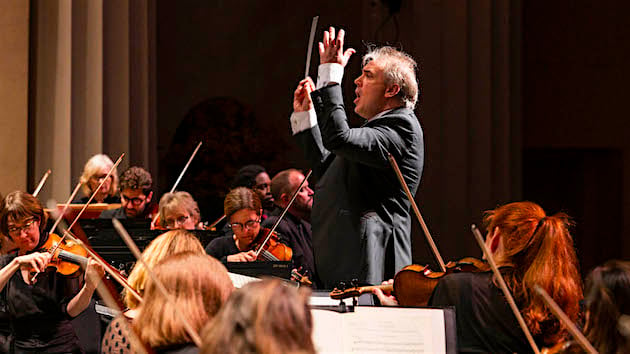
Your love of new music is evident. You’ve appointed Ellen Reid, who won the Pulitzer Prize last year, to succeed Andrew as LACO’s creative advisor and composer-in-residence. You’ll also be working with composers Derrick Spiva Jr., Missy Mazzoli, and Juan Pablo Contreras. Why is presenting new music important to you?
It’s very exciting to conduct a new piece. You don’t have any reference and you have to imagine the sounds in your head. You have to have a very close relationship with the score — the process of studying it and getting to know it. But the first rehearsal when you hear these sounds for the first time, this is when it starts being alive. Andrew will be around for rehearsal, which is a luxury.
Imagine if you have Beethoven’s Symphony No. 7 and you can ask him, ‘What do you think about this? Is it too fast or too slow?’ We can do this with Andrew’s piece when he hears it for the first time. Until that moment, it’s only little scribbles on a piece of paper. The chance to correct or modify things is a very exciting process and always we look forward to that.

You’ve said that your job is to focus the energy of every musician, to play music in a particular way, to give meaning to the notes. How do you do that?
What do we want the audience to feel at this particular moment? Comfortable, hot or warm or cold or afraid? We have lot of things we can play with, but my way of interpreting this story is to make sense of it for us today and to transmit that to the audience. I believe the audience will be engaged with what happens on the stage if there is energy and commitment coming from the stage.
We try to play a concert like there is no tomorrow — like it’s the last thing we do in our lives. It’s a life event and you cannot repeat a life event. Whatever we do today we can’t repeat tomorrow. Tomorrow the temperature is different — we all feel different — and it’s going to affect the performance. There are so many things that affect the way we perform, but it’s the excitement of a live concert. This is the reason when I was 9 and was in tears. I felt that what was in front of was something I would never be able to see again. When I am performing I want to believe that one person in the audience will be feeling the same.
Do you find it serendipitous that you not only run the music festival in Santander, but that now you are also music director of LACO, an ensemble you heard so much about from Marriner?
Life is a funny thing. It’s almost like circles, because I was introduced to music here, and now I’m the music director. I was really close to Marriner, who used to talk to me about LACO, and here I am. Neville died two years before I was offered the job, and Molly Marriner, his widow, called me when she heard, and said, “Why don’t you have tea with me?”
I came to her house and we went into Neville’s studio and she said, “I have something for you.” It was a case which I knew from the time I played with him. He carried all his batons in this case, and Molly said, “I want you to have it.” I opened it and it was full of Neville’s batons, so now I have with me his batons in his beautiful brown leather case. It is amazing, and I have to say I haven’t used them yet, but I have to do my opening [LACO] concert with one of them.
